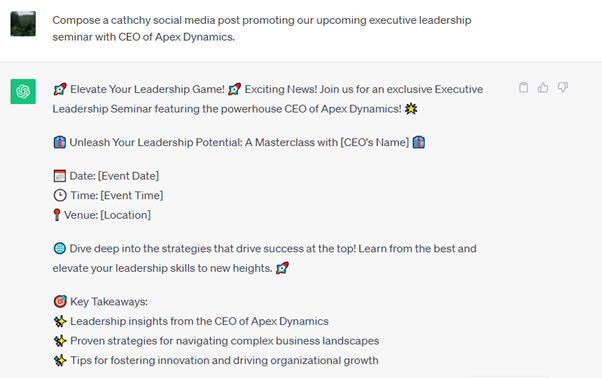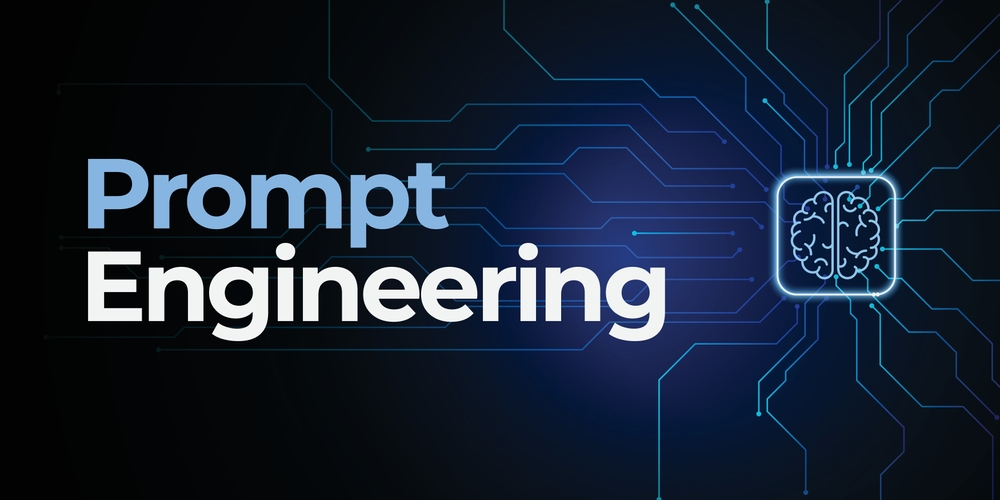Highlights:
- While prompt engineering is a recent field, it intricately connects with the broader historical context of natural language processing (NLP) and machine learning.
- It has become pivotal with the widespread adoption of transformer-based models across industries and everyday applications.
AI prompts are the silent architects shaping conversations between human intent and machine intelligence.
In the ocean of AI, prompting involves skillfully devising inputs or queries that direct artificial intelligence systems to produce pertinent and precise responses. The prompt engineering definition revolves around creating successful prompts that exhibit clarity, conciseness, and focus. This process involves tailoring prompts to effectively guide AI models in generating relevant and accurate responses or outputs based on specific tasks or objectives.
Undoubtedly, the significance of effective prompting cannot be emphasized enough. It serves as a crucial element in optimizing the capabilities of AI technologies and ensuring a smooth and user-friendly experience.
Let’s delve into the prompt engineering more precisely through experimentation:
Imagine you’re organizing a leadership seminar for your company, Apex Dynamics, featuring an insightful session with the CEO. As you are eager to promote this event, you task a generative AI chatbot with the prompt: “Compose a compelling social media post promoting our upcoming executive leadership seminar.”
Here’s the output:

Let’s make another attempt. This time, provide a more specific prompt: “Compose a catchy social media post promoting our upcoming executive leadership seminar with the CEO of Apex Dynamics.”
Here is the output from the model with the refined prompt:

It stands out as an excellent prompt engineering example, illustrating how precise prompts serve as a strategic communication tool. It also influences the nature and quality of content generated by the language model. This dynamic evolution is not merely a chronological progression but an ongoing journey that redefines the boundaries of linguistic interaction in artificial intelligence.
The Evolution of Engineering Prompts
Prompt engineering, though a relatively recent field, is intricately tied to the broader history of natural language processing (NLP) and machine learning. Grasping its evolution provides a backdrop to its current significance.
Let’s discuss its evolution step by step:
-
The dawn of NLP
NLP’s roots trace back to the mid-20th century, coinciding with the rise of digital computers. Initial NLP endeavors were rule-based, relying on manually crafted rules and basic algorithms. These systems were rigid, struggling with the intricacies and subtleties of human language.
-
Statistical NLP and machine learning
As computational power surged and datasets expanded, the late 20th and early 21st centuries witnessed a transition to statistical methods. Machine learning algorithms became pivotal, enabling more adaptable and data-driven language models. Nonetheless, these models faced challenges in comprehending context and generating coherent long-form text.
-
Rise of transformer-driven models
The introduction of the transformer architecture in the 2017 paper “Attention is All You Need” marked a pivotal moment. With self-attention mechanisms, transformers could process vast data and capture intricate language patterns. This spurred the creation of models like Google’s BERT, revolutionizing tasks such as text classification and sentiment analysis.
-
Influence of OpenAI’s GPT
OpenAI’s Generative Pre-trained Transformer (GPT) series, especially GPT-2 and GPT-3, propelled transformers to new heights. With billions of parameters, these models exhibited an unparalleled capability to produce text that is coherent, contextually relevant, and frequently indistinguishable from human-generated content.
The ascent of GPT models emphasized the importance of prompt engineering, where output quality heavily relies on prompt precision and clarity.
-
Current prompt engineering
It has emerged as a critical discipline with the widespread adoption of transformer-based models across industries, research, and everyday applications. It acts as the pathway to ensure these powerful models are used effectively, making AI tools easier to use and more accessible.
Whether it’s unleashing creativity with generative AI or utilizing ChatGPT for data science projects, a profound understanding of how prompts operate is becoming increasingly indispensable.
Moving beyond evolution, we’ll explore the importance of prompt engineering in marketing success. Learn how businesses leverage this innovative approach to enhance marketing strategies and achieve marketing goals.
The Prompt Engineering in Marketing Success
Have you ever observed the contrast in AI-generated copy quality among copywriters? While some effortlessly produce excellent content, others grapple with refining and rewriting. The art of prompt engineering is the key to achieving AI-generated copy that’s relevant, engaging, persuasive, and devoid of hallucination or bias.
Key tips for crafting effective marketing copy prompts:
- Know your audience: Understand your target audience’s concerns and needs to tailor prompts that resonate with them.
- Clarity is key: Ensure your prompts are concise enough to help the AI model accurately interpret your requirements. Avoid jargon for effective communication.
- Unleash creativity: The creativity of your prompts influences the uniqueness and engagement of AI-generated copy. Experiment with diverse prompts for optimal results.
By incorporating these tips, you can craft prompts that effectively guide language models to generate marketing copy aligned with your brand, audience, and campaign objectives. Also, the strategic framework provided by this technology plays a pivotal role in empowering marketers to harness the capabilities of language models effectively.
Prompt engineering assists marketers in the following ways:
-
Content creation
Prompts in AI-driven content creation revolutionize conventional methods. Marketers can rapidly generate high-quality content at scale by guiding AI with carefully crafted prompts. This technique also facilitates tailored content for specific audiences, like conversational tech blogs for enthusiasts or formal health tips for the health-conscious. Prompt engineering for copywriting also works well.
-
SEO
By steering AI through prompts, tasks such as identifying keywords, formulating SEO-friendly meta descriptions, and optimizing content for SEO have become more efficient.
For example, a prompt can steer AI to create a blog post on sustainable fashion, seamlessly integrating relevant keywords and generating an SEO-optimized meta description. This proactive approach enhances search engine rankings, improving visibility to the target audience. In this way, prompt engineering for SEO works.
-
Personalization
Prompt engineering revolutionizes marketing personalization by allowing meticulous adjustment of prompts, enabling marketers to tailor AI outputs to specific customer segments. By adeptly harnessing AI capabilities and fine-tuning prompts, marketers can orchestrate campaigns that not only capture attention but also forge meaningful connections.
This approach sets a new standard for personalized marketing excellence, reflecting a sophisticated understanding of audience nuances and preferences.
-
Customer segmentation
Audience segmentation lies at the core of effective marketing strategies. By using prompt engineering, marketers can craft content that goes beyond being noticed—it truly captivates, communicates with, and connects with the diverse aspects of their customer audience.
Tailoring content variations to different demographics, behaviors, and preferences ensures a communication strategy that is both impactful and tailored, enhancing the overall effectiveness of marketing campaigns.
-
Adaptability to trends
By adeptly leveraging prompt engineering, marketers gain the ability to align their messaging with prevailing trends and events swiftly. This involves the quick adjustment of prompts to capture the essence of what’s current and relevant.
For example, when there’s a cultural event, a product launch, or a major industry change, marketers can adjust prompts to ensure the content created fits in smoothly.
-
Persona creation
Creating personas with prompt engineering involves leveraging language models to generate detailed and nuanced descriptions of fictional characters that represent specific target audience segments. This process aids marketers in understanding and empathizing with their audience, ultimately guiding the development of more effective and personalized marketing strategies.
Basically, it helps marketers create personalized and flexible campaigns, improving their understanding of the audience. It makes testing easier and allows quick responses to trends, all contributing to overall marketing success.
Conclusion
In conclusion, prompt engineering plays a pivotal role in the field of marketing, serving as a strategic tool to guide artificial intelligence in various tasks. Within the business context, whether employing prompt engineering for copywriting, generating captivating social media content, optimizing for search engines, or other purposes, it enables marketers to maximize the efficiency of AI utilization.
As technology continues to evolve, mastering the nuances of prompt engineering in marketing will be crucial for staying ahead in the dynamic landscape of digital advertising and communication. The ability to craft precise and impactful prompts ensures that AI systems can assist marketers in delivering messages that resonate with their target audience, ultimately contributing to the success of marketing campaigns in an increasingly digital and competitive world.
Enhance your expertise by accessing a range of valuable AI-related whitepapers in our resource center.





























































